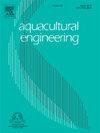Impact of different culture substrates on the water environment and growth performance of Babylonia areolata in a recirculating aquaculture system
IF 4.3
2区 农林科学
Q2 AGRICULTURAL ENGINEERING
引用次数: 0
Abstract
This study evaluates the effects of different substrates (PVC culture nests, ceramic particles, and sand) on Babylonia areolata's growth performance, water environment, and microbial community in a recirculating aquaculture system (RAS). A RAS, integrating vertical sedimentation tanks, nano-aeration devices, and foam separation equipment with ecological culture nests, was designed to address issues in traditional culture models. Over 180 days, water quality parameters, microbial diversity, growth condition, and enzyme activity of B. areolata were monitored. Water quality remained stable: dissolved oxygen was 5.04–7.98 mg/L, pH 7.26–8.46, ammonia nitrogen 0.05–0.25 mg/L, and nitrite nitrogen 0.021–0.069 mg/L. Different substrates significantly affected snail growth and water environment regulation. The sand group had the highest final shell length (35.46 ± 3.02 mm) and body weight (11.5 ± 1.04 g), while the ceramic particle group showed lower growth rates. Microbial community analysis revealed higher diversity in PVC and sand substrates (Shannon index 6.83–6.91), and the ceramic particle group had significant enrichment of some antibiotic resistance genes (ARGs). Enzyme activity analysis indicated dynamic changes in antioxidant and digestive enzymes. Lipase activity in the ceramic particle group was significantly lower than in other groups (p < 0.05). In conclusion, PVC ecological culture nests combined with the efficient water treatment system can maintain stable water quality and support high - density culture (1500 ind./m²). This study provides a feasible technical solution for B. areolata recirculating aquaculture and scientific insights for substrate selection and ARGs control.
在循环水养殖系统中,不同基质对浅纹巴比伦鱼水环境和生长性能的影响
本研究评估了不同基质(PVC培养巢、陶瓷颗粒和沙子)对循环水养殖系统(RAS)中小乳斑巴比伦鱼(Babylonia areolata)生长性能、水环境和微生物群落的影响。为解决传统养殖模式存在的问题,设计了集垂直沉淀池、纳米曝气装置、泡沫分离设备和生态养殖巢于一体的RAS。在180 d的时间里,对乳晕白螺旋藻的水质参数、微生物多样性、生长条件和酶活性进行监测。水质保持稳定,溶解氧5.04-7.98 mg/L, pH 7.26-8.46,氨氮0.05-0.25 mg/L,亚硝酸盐氮0.021-0.069 mg/L。不同基质对蜗牛生长和水环境调节有显著影响。砂粒组的末壳长(35.46 ± 3.02 mm)和重(11.5 ± 1.04 g)最高,陶瓷粒组的生长速率较低。微生物群落分析显示,PVC和砂土基质具有较高的多样性(Shannon指数为6.83 ~ 6.91),陶瓷颗粒组中部分抗生素耐药基因(ARGs)显著富集。酶活性分析显示抗氧化酶和消化酶发生了动态变化。陶瓷颗粒组脂肪酶活性显著低于其他各组(p <; 0.05)。综上所述,PVC生态养殖巢与高效水处理系统相结合,可以保持稳定的水质,支持高密度养殖(1500 ind./m²)。本研究为沙纹白藻循环水养殖提供了可行的技术解决方案,并为底物选择和ARGs控制提供了科学见解。
本文章由计算机程序翻译,如有差异,请以英文原文为准。
求助全文
约1分钟内获得全文
求助全文
来源期刊

Aquacultural Engineering
农林科学-农业工程
CiteScore
8.60
自引率
10.00%
发文量
63
审稿时长
>24 weeks
期刊介绍:
Aquacultural Engineering is concerned with the design and development of effective aquacultural systems for marine and freshwater facilities. The journal aims to apply the knowledge gained from basic research which potentially can be translated into commercial operations.
Problems of scale-up and application of research data involve many parameters, both physical and biological, making it difficult to anticipate the interaction between the unit processes and the cultured animals. Aquacultural Engineering aims to develop this bioengineering interface for aquaculture and welcomes contributions in the following areas:
– Engineering and design of aquaculture facilities
– Engineering-based research studies
– Construction experience and techniques
– In-service experience, commissioning, operation
– Materials selection and their uses
– Quantification of biological data and constraints
 求助内容:
求助内容: 应助结果提醒方式:
应助结果提醒方式:


